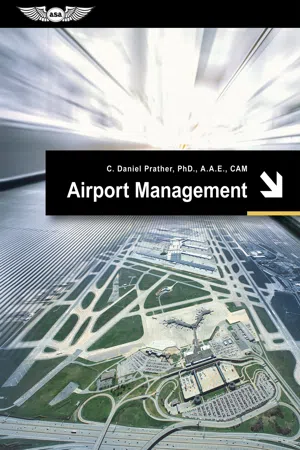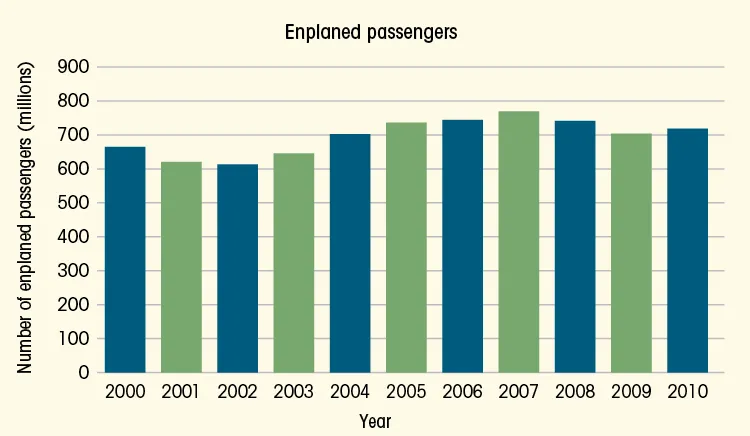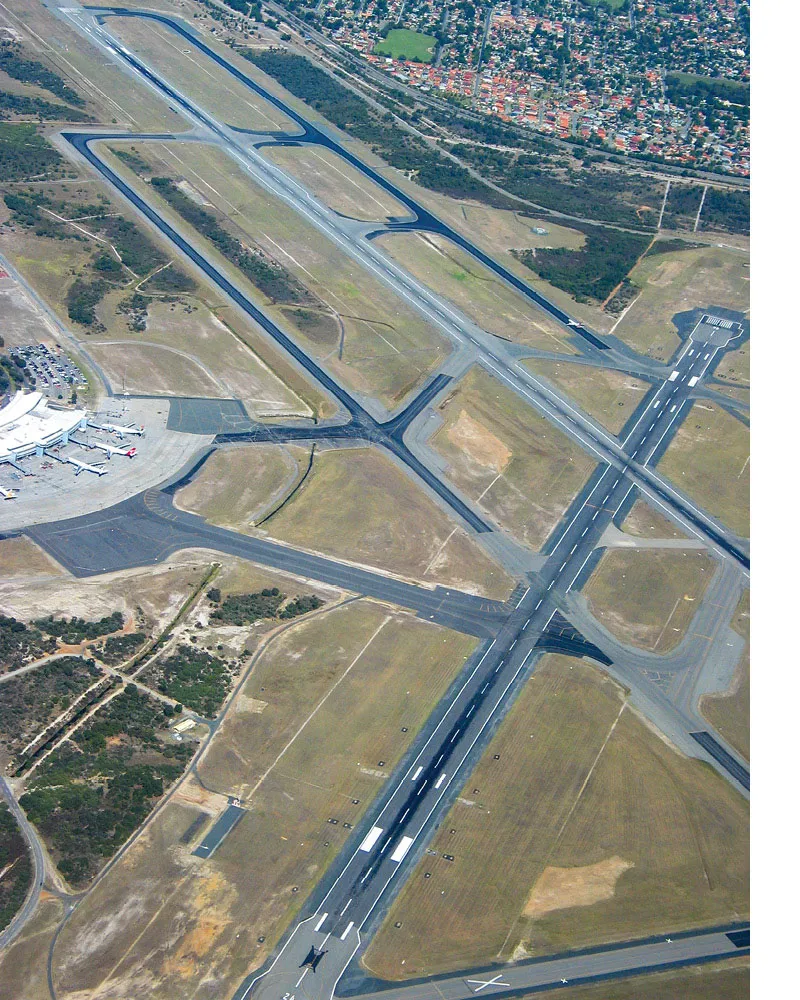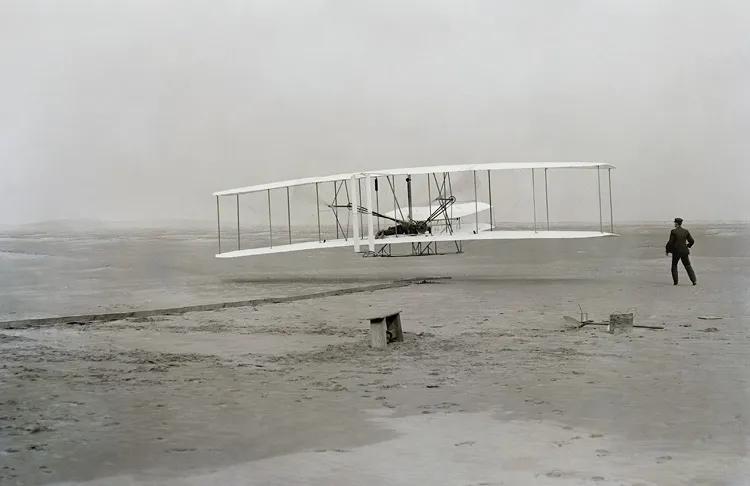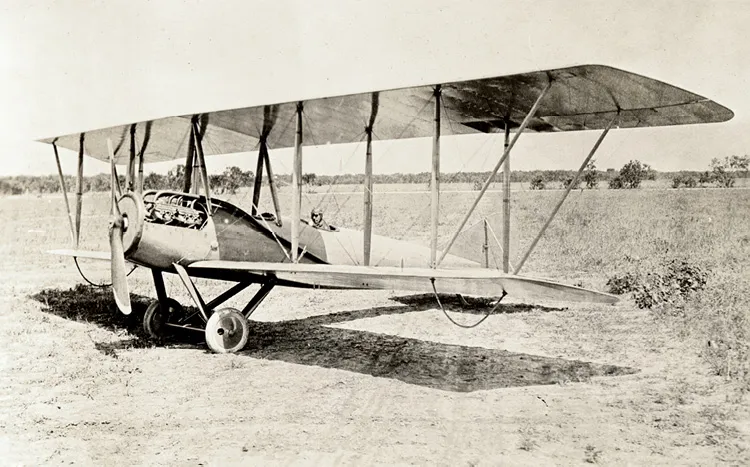Chapter 1
Historical Overview
Upon completion of this chapter, you should:
- Understand the historical events and important pieces of legislation affecting the development of airlines.
- Understand the historical events and important pieces of legislation affecting the development of airports.
- Understand the historical funding of airport development.
- Understand the pre- and post-deregulation periods.
- Understand the significance of the events of 9/11 on the aviation industry.
- Be able to discuss contemporary issues and future challenges confronting the airport industry.
14 CFR Part 139, Certification of Airports
AIP Temporary Extension Act
Air Cargo Deregulation Act of 1976
Air Commerce Act of 1926
Airline Deregulation Act of 1978
Airport and Airway Development Act of 1970
Airport and Airway Improvement Act of 1982
Airport and Airway Revenue Act of 1970
Airport and Airway Safety and Capacity Expansion Act of 1987
Airport and Airway Safety, Capacity, Noise Improvement, and Intermodal Transportation Act of 1992
Airport and Airway Trust Fund
Airport Development Aid Program (ADAP)
Airport Improvement Program (AIP)
Airways Modernization Act
Americans with Disabilities Act of 1990
Aviation and Transportation Security Act (ATSA) of 2001
Aviation Investment and Reform Act for the 21st Century (AIR-21)
Aviation Safety and Capacity Expansion Act of 1990
Aviation Safety and Noise Abatement Act of 1979
Aviation Security Improvement Act of 1990
cargo revenue ton miles
Civil Aeronautics Act of 1938
Civil Aeronautics Administration (CAA)
Civil Aeronautics Authority (CAA)
Civil Aeronautics Board (CAB)
Civil Works Administration (CWA)
Clean Air Act
continuing resolution
Contract Air Mail Act of 1925
Contract Air Mail (CAM) routes
Department of Transportation Act of 1966
Development of Landing Areas for National Defense (DLAND)
Emergency Relief Appropriation Act of 1935
Essential Air Service (EAS)
Federal Aid to Airports Program
Federal Airport Act of 1946
Federal Aviation Act of 1958
Federal Aviation Administration Authorization Act of 1994
Federal Aviation Agency (FAA)
Federal Aviation Reauthorization Act of 1996
Federal Emergency Relief Administration (FERA)
Federal Water Pollution Control Act
general aviation (GA) airports
Homeland Security Act of 2002
hub and spoke
Implementing Recommendations of the 9/11 Commission Act of 2007
Kelly Act
load factors
low-cost airlines
Military Airport Program (MAP)
National Airport Plan
National Civil Aviation Review Commission
National Commission on Terrorist Attacks Upon the United States
National Transportation Safety Board (NTSB)
oligopolistic
omnibus spending bill
passenger facility charge (PFC)
Planning Grant Program (PGP)
revenue passenger miles
Security Guidelines for General Aviation Airports
spending bill
State Block Grant Program
Transportation Security Administration (TSA)
Vision 100—Century of Aviation Reauthorization Act of 2003
Works Progress Administration (WPA)
World War I
World War II
Features in Chapter 1
The Role of Federal Express in the Air Cargo Industry
Federal Express played an integral role in establishing the air cargo industry and the subsequent deregulation of that industry.
The Rise and Fall of People’s Express
A low-cost airline that attained great success, but eventually went out of business due to competition from other airlines during the deregulated era.
Introduction
Airports are an integral part of the aviation industry. In this industry, billions of passengers and billions of tons of cargo have been moved from point to point since it began, which could not have occurred without airports. The industry is a little more than 100 years old and yet responsible for more than $1 trillion per year in economic activity and almost 10 million jobs. Consider the U.S. airlines (Figure 1-1). Although down from a ten-year high of 769.6 million enplaned passengers in 2007, U.S. airlines enplaned 720.5 million passengers, which equates to 798 billion revenue passenger miles, in 2010. Additionally, airlines generated more than 27 billion cargo revenue ton miles and generated more than 10 million departures during the year (Air Transport Association, 2011).
Figure 1-1. Number of enplaned passengers, U.S. airlines, 2000–2010
Each of these departures, passengers, and pounds of cargo were accommodated at an airport. Whether large or small, public or private, airports serve as an interface between ground and air transportation (Figure 1-2). As an industry, they directly serve the needs of pilots, passengers, and meeters and greeters, and provide employment to hundreds of thousands of employees nationwide. Indirectly, they serve the communities in which they are located by providing facilities to support emergency medical transport, law enforcement services, and the movement of goods and services. Even general aviation (GA) airports provide beneficial economic impacts to the local community. Airports in the United States have a significant impact on local, state, regional, and national economies. As part of an industry that provides 10 million jobs, $396 billion in wages, and an impact of $1.3 trillion to the economy, airports clearly play a crucial role in the aviation industry (Federal Aviation Administration, n.d.). In sum, airports serve a unique and substantial need throughout the world, and have an interesting history in the United States—the birthplace of aviation.
Figure 1-2. Airports are transportation lifelines, often serving airline passengers and cargo carriers, flight training and general aviation pilots, with beneficial economic impacts felt locally, regionally, and nationally. (jlye/Bigstock.com)
The Beginning of an Industry
The history of the aviation industry in the United States began on December 17, 1903. It was on this day that Orville Wright first flew the now-famous Wright Flyer I in a controlled flight lasting 12 seconds (see Figure 1-3). However, aviation did not immediately succeed. After these first flights at Kitty Hawk, North Carolina, the Wright brothers faced quite a challenge in promoting their aircraft to a willing buyer. In fact, five years passed before they were able to convince the U.S. government to test a much improved version.
Figure 1-3. The first flight of Orville Wright (1871–1948) at Kill Devil Hills, Kitty Hawk, North Carolina, on December 17, 1903 (120 feet in 12 seconds). His brother Wilbur Wright (1867–1912) is standing on the right. (Wikimedia Commons; see credit following Appendix B)
Although the four flights flown by the Wright brothers on that day marked the beginning of controlled, powered, and sustained heavier-than-air human flight, the first scheduled commercial airline flight using heavier-than-air aircraft did not occur until eleven years later, when on January 1, 1914, Tony Jannus piloted the Benoist XIV flying boat biplane across Tampa Bay (Florida) on an historic 23-minute flight (see Figure 1-4). This inaugural flight also carried the mayor of St. Petersburg, Florida—Mr. Abram C. Pheil. At a fare of five dollars per passenger, this was the first time in history that tickets were sold to the general public for point-to-point scheduled air travel. Known as the St. Petersburg-Tampa Airboat Line, the airline offered service six days per week with two roundtrip flights daily until ceasing service on March 31, 1914, which was five weeks after the termination of a three-month contract that had been signed with the St. Petersburg Board of Trade. This service greatly improved travel between the two cities, as travel by steamship took 2 hours, rail between 4 and 12 hours, and automobile around 20 hours (Bluffield, 2010).
Figure 1-4. The historic departure of Jannus and Pheil. (Wikimedia Commons; see credit following Appendix B)
Although the early days of aviation did not start and end at airports as we know them, these airfields did serve as the first airports. Whether in the form of a grassy field, sand dune, body of water, or other flat place, these first airfields served the unique needs of the early aviators. As more aircraft were built and the aviation industry began growing, the need for landing areas grew. Providing dedicated airfields was seen as the best solution to this need. One way in which to do this was to develop dirt-only fields (see Figure 1-5). This option improved aircraft performance on takeoff roll, due to an elimination of the drag produced by grass. As can be imagined, however, these dirt landing sites were only usable in dry conditions. Muddy landing sites were, in fact, worse than the old grass landing sites. Often, race tracks, golf courses, or fairgrounds doubled as landing sites.
Figure 1-5. Early landing strip. (©iStock.com/andipantz)
A significant boost in the quality of airfields came about with the addition of concrete landing areas. Portland cement, which had been invented in 1824 by English inventor Joseph Aspdin, was the preferred material. However, macadam or cinders were also used. Macadam was a type of road construction pioneered by Scotsman John Loudon McAdam around 1820. Single-sized aggregate layers of stone with a coating of binder as a cementing agent were mixed in an open-structured macadam. Cinder, on the other hand, is a small type of volcanic rock that has many uses, including material for road construction and decorative rock for landscaping, especially in the southwest U.S.
Possibly the first use of the term “airport” was by a Brazilian airship inventor, Mr. Alberto Santos-Dumont. According to the April 11, 1902 edition of The New York Times, Mr. Santos-Dumont explained his expectation that the city of New York would be “the principal ‘airport’ of the world in less than a score of years” (The New York Times, 1902). However, the nation’s first mun...
